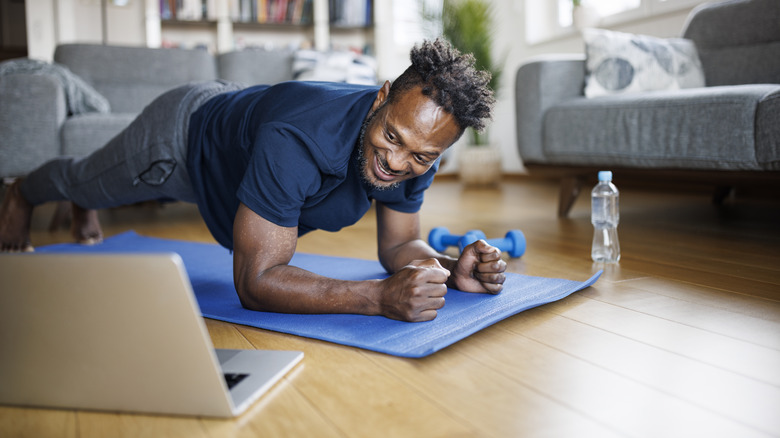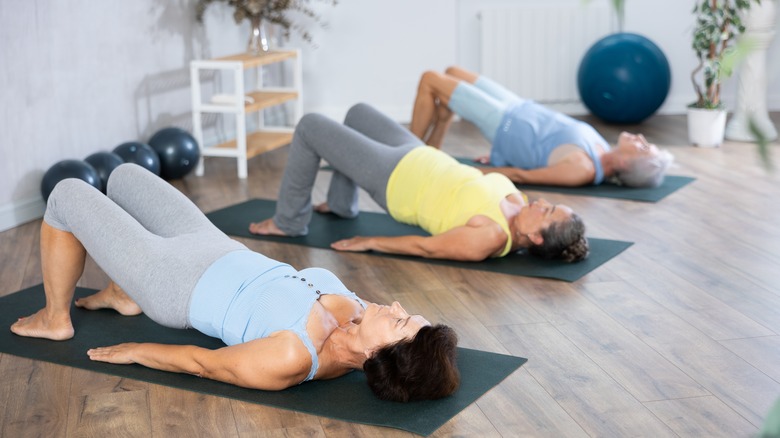The Low-Impact Exercise That Can Prevent Bladder Leaks
An unexpected bladder leak can have you hightailing it for the bathroom, or shifting around uncomfortably in your chair as you try desperately to avoid that damp spot in your underwear. Thankfully, we don't have to be left at the mercy of our bladder. Experts at the National Health Service (NHS) explain that low-impact exercises targeting our pelvic floor muscles may help minimize the risk of leakage, which includes the ever popular Pilates.
Bladder leaks, otherwise referred to as urinary incontinence or overactive bladder, often affect women and older adults. But any person of any age is susceptible to bladder leaks, according to the National Institute on Aging. In fact, sometimes all it takes is a bout of cold weather to ramp up an overactive bladder. When outdoor temperatures drop, so does our body temperature. This prompts our bladder muscles to constrict, which only adds to the muscle spasms already responsible for an overactive bladder in the first place (via Alliance Urology Specialists). As a result, some people experience urinary continence more often during the winter months.
Whether due to a snowy December, a poorly-timed sneeze, or weakened pelvic floor muscles from childbirth, attending a weekly Pilates class may help keep your underwear a little drier.
How Pilates exercises strengthen the pelvic floor
Pilates involves a combination of breathing techniques and exercises that target your core and pelvic floor muscles. Researches from a 2020 study published in the Journal of Alternative and Complementary Medicine explain that when breathing in, the diaphragm becomes activated and the pelvic floor muscles elongate. Upon releasing the breath, the transverse abdominal muscle and pelvic floor muscles contract. Together, this strengthens the structures of the urinary system, reproductive system, and the combined functioning of the lumbar spine and the pelvis.
In the study, 18 women between the ages of 45 and 70 experiencing stress urinary incontinence underwent a 12-week-long community-based Pilates program twice a week. Although there are different kinds of urinary incontinence, stress urinary incontinence pertains to bladder leaks caused by an abrupt boost in intra-abdominal pressure, such as when coughing. The study findings showed that, after six months, participants reported significant reductions in bladder leaks. Although more in-depth research is needed, the study team highlighted that community Pilates pelvic floor muscle training programs may be an effective and adherable supplemental treatment method for reducing symptoms of stress urinary incontinence.
Try these three Pilates exercises to help reduce bladder leaks
Although considered a low-impact exercise, there are some beginner moves you'll want to start with if you're new to Pilates. There are great pelvic floor-specific moves, including the cat/cow exercise. As outlined by Level 4 PT & Pilates, begin on your hands and knees with your hands placed squarely underneath your shoulders and your knees aligned underneath your hips. Taking a deep breath, arch your spine upwards while pushing down on your hands and feet. Hold for 5 seconds before exhaling and bringing your spine back to its original position.
Another move that can benefit the pelvic floor muscles is the bridge pose. Lay flat on the floor with your knees bent, and feet firmly in place. As you breathe in, lift your hips off the ground and activate your glute muscles while pushing your feet into the ground. Maintain this position for 5 seconds before slowly lowering yourself back down on an exhale.
Finally, there are pelvic tilt exercises. Think of these as a baby bridge pose. Start in the same position, but instead of lifting your hips off the ground, simply flatten your back against the floor by activating your abdominal muscles and giving your pelvis a slight tilt upwards towards you (via Mayo Clinic). Hold this position for 10 seconds before releasing and repeating. Take your pick of any of these three Pilates moves, and try working up to ten repetitions for three days a week.



